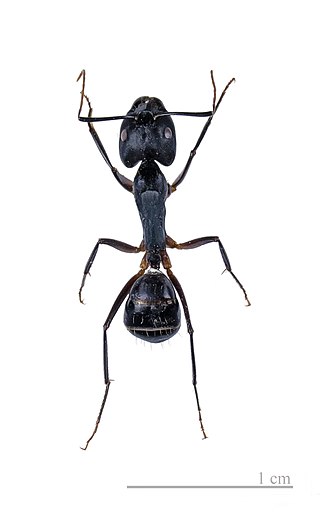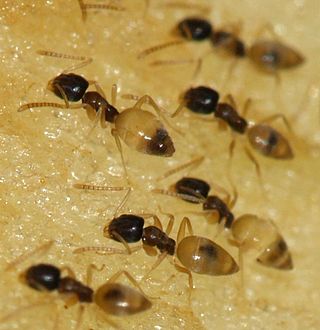
The Formicinae are a subfamily within the Formicidae containing ants of moderate evolutionary development.

Tapinoma is a genus of ants that belongs to the subfamily Dolichoderinae. The genus currently comprises 74 described species distributed worldwide in tropical and temperate regions. Members of are generalized foragers, nesting in a wide variety of habitats, ranging from grasslands, open fields, woodlands, to inside buildings. The majority of species nest in the ground under objects such as stones or tree logs, other species build nests under bark of logs and stumps, in plant cavities, insect galls or refuse piles.

Anonychomyrma is a genus of ants in the subfamily Dolichoderinae.

Aphaenogaster is a genus of myrmicine ants. About 200 species have been described, including 18 fossil species. They occur worldwide except in South America south of Colombia, sub-Saharan Africa, and Antarctica.

Cardiocondyla is an Old World genus of ants in the subfamily Myrmicinae.

Plagiolepis is an ant genus of the formic acid-producing subfamily Formicinae. The genus is found in tropical and temperate regions of the Old World.

Tetramorium is a genus of ants in the subfamily Myrmicinae that includes more than 520 species. These ants are also known as pavement ants.

Crematogastrini is a tribe of myrmicine ants with 64 genera and 8 fossil genera.

Myopias is a genus of ants in the subfamily Ponerinae. The genus is known from the Oriental, Indo-Australian, and Australasian regions.

Rhytidoponera is a large genus of ants in the subfamily Ectatomminae. The genus is known from Australia and Melanesia, with New Caledonia as the most eastern limit.

Technomyrmex is a genus of ants in the subfamily Dolichoderinae. With 98 species, it is one of the largest and most diverse ant genera in the Dolichoderinae. The genus distributed throughout the tropical and subtropical zones with most species occurring in the Oriental-Malesian and Afrotropical regions. One species, Technomyrmex albipes is a tramp ant now widespread throughout the tropics due to human activities.

Podomyrma is a genus of ants in the subfamily Myrmicinae.

Meranoplus is an Old World genus of ants in the subfamily Myrmicinae. With over 80 valid species, it is predicted that over half of the Meranoplus diversity remains undescribed, most of these from Australia.

Melophorus is a genus of ants in the subfamily Formicinae. The genus is endemic to Australia, where its species are common in arid and semiarid areas.

Prolasius is a genus of ants in the subfamily Formicinae. Of the genus' 19 species, 18 are known from Australia and one from New Zealand. They nest in soil under rocks or logs, sometimes in trees.

Pseudolasius is a genus of ants in the subfamily Formicinae. The genus is known from southern Asia to northern Australia, where it appears to be restricted to tropical areas. These ants are commonly known as twig ants due to their habit of nesting in twigs or hollow stems.

Lioponera is a genus of ants in the subfamily Dorylinae containing approximately 74 described species. The genus is distributed widely across the Afrotropical, Australasia, Indomalaya, Malagasy, and Palearctic bioregions. Lioponera was described by Mayr (1879) and later placed as a junior synonym of Cerapachys by Brown (1975). Lioponera was resurrected as a valid genus by Borowiec (2016) during redescription of the doryline genera.

Mayriella is an Indo-Australian genus of ants in the subfamily Myrmicinae. Colonies in this genus are very small, typically consisting of 50 - 100 individuals. Mayriella is classified in the genus of Hymenoptera in the family ants. They are diurnal.


















